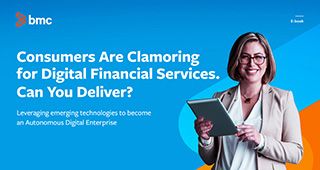Not long ago, financial services (FinServ) institutions and financial technology (FinTech) companies were seen as natural adversaries with a familiar storyline: legacy industry giants under threat of disruption from nimble, digital-first newcomers. But the reality of the situation has proven more nuanced.
While deep resources and a broad market reach have offered powerful business advantages for FinServ organizations, FinTechs have had a better handle on the innovation needed to drive transformation, modernize systems, and enable a new generation of experiences and value for customers.
Now, FinServ and FinTech organizations are realizing they have something to gain from working together—and they’re starting to act accordingly.
Defining FinServ
FinServ institutions—banks, investment houses, lenders, finance companies, foreign exchange services, stock brokerages, credit unions, real estate brokers, and insurance companies—help businesses and consumers save, borrow, invest, move, and manage money and are the largest sector in the global economy in terms of earnings and equity market capitalization. Their services include everything from processing consumer credit card transactions to financing corporate acquisitions to helping individuals prepare tax returns and multinational corporations manage their financial risk.
Defining FinTech
Playing a complementary role to FinServ firms, FinTechs leverage new technologies like automation and artificial intelligence (AI) to improve and automate the delivery and use of financial services. By giving consumers and companies better ways to manage their financial operations—from personal bank accounts to split-second stock trades and algorithm-driven risk calculations—FinTechs help their customers earn more, save more, and make better decisions about their money.
Initially focused on the backend systems of established FinServs, FinTechs have increasingly moved into consumer-facing markets. Working across sectors that span education, retail banking, nonprofit, investment management, and cryptocurrency, FinTechs place a premium on rapid technological innovation, market agility, and consumer-centric experiences and branding.
Current trends and changing tides
Today, FinTechs and FinServs are actively seeking opportunities for cooperation, co-development, partnership, and sometimes, even acquisition. In a recent report on digital transformation in banking, Gartner® discusses the challenges FinServ is facing from FinTechs, and offers recommendations for productive collaboration between the two.
For FinServs, these alliances can speed the time-to-market for innovations such as AI-driven insights, which can translate into new revenue opportunities and competitive differentiation. In a roundtable hosted by Gartner in November 2021, commercial banking and treasury leaders from major North American financial institutions agreed that “commercial banks lag retail and small business banking in the use of data to provide client value and must catch up.”
Cybercrime is also an issue that FinServ and FinTech collaboration can address. A subsequent Gartner blog post, “5 Commercial Banking Trends to Watch in 2022,” notes, “Banks are seeing cyber-fraud increase substantially and are doing more to monitor and preempt issues through data analysis. Some commercial banking leaders are considering productizing these data assets and skills as a value-add for clients.” FinTechs can help banks and credit card issuers use data insights to power automated fraud detection, flag suspicious attempted transactions, and notify customers before they are approved.
Separately, Deloitte notes that investment banks challenged by other trends such as evolving financial regulation and a rise in remote work and client sophistication will likely need to “retool certain business models and operational platforms” and “optimize the use of financial technology, data, and analytics to generate differentiated insight and added value.”
FinServ firms can get a crucial head start on these efforts—without investing in and developing those capabilities from the ground up—by collaborating with FinTech organizations. FinTechs can benefit as well, leveraging collaborative relationships to drive growth; scale and evolve their capabilities; and ultimately, build a more robust and sustainable business—whether freestanding or as an acquisition target.
Learn more about FinServ and FinTech in the Industry Topics section of BMC Blogs, and find out about BMC innovations for FinServ here.







